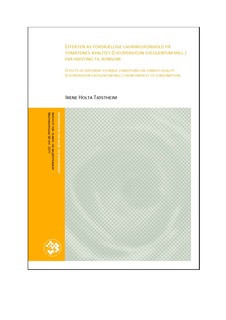| dc.description.abstract | This master thesis is part of a project at Bioforsk Vest, Særheim. The main purpose is to find the optimal growth methods and transport- and storage conditions to maintain the quality and the potentially health-promoting constituents of tomatoes (Lycopersicon esculentum Mill.) from harvest to consumption. In this part 8 different storage regimes were simulated. To evaluate the quality, firmness and color of the tomatoes were measured, and levels of soluble solids (SSC), total titrable acids (TTA), chalconaringenin (CN), rutin, apiosyl rutin, lycopene and β-carotene were analyzed during post-harvest ripening. The flavonoids and carotenoids were determined using high-performance liquid chromatography (HPLC). Two quite different tomato cultivars (‘Dometica’ and ‘Susanne’) were used in the study. There were two harvest dates, and the tomatoes were harvested at 3 different maturity levels; green (MG1), pink (MG2) and red (MG3). After harvest the tomatoes were stored at different temperatures (2, 8, 12 and 15°C) in darkness the first 4 days after harvesting (transport simulation), and 4 groups were stored under direct lightening, exposed for ethylene gas (150 ppm, simulation of outer exposure during transport) or UV-C radiation (1650 µmol) in 15 or 90 seconds. After the 4 days treatment period all groups of tomatoes were stored at 22°C under direct lightening for 18 days (shelf life simulation), except the tomatoes stored at 12°C who remained in the same temperature and darkness during the study. Samplings during post-harvest ripening were performed at harvest day, day 4, day 7, day 15 and day 22. The analyses revealed that in most cases, cultivar type had a greater effect than the different temperatures or storing under direct lightening, or exposure to ethylene gas and UV-C radiation. Contents of the carotenoids lycopene and β-carotene were significantly higher in tomatoes radiated with UV-C for 90 seconds than treatments without UV-C radiation, and treatment with 15 seconds UV-C radiation. SSC contents were higher in tomatoes harvested at MG3 than MG1 and 2, whereas TTA contents were higher in tomatoes harvested at MG1 than MG3. Cv. Susanne had higher levels of SSC, TTA, flavonoids and carotenoids than cv. Dometica, whereas cv. Dometica developed the deepest red color and maintained the highest firmness during the storage period. In general the firmness, SSC and TTA levels decreased during storage, which can affect the taste and quality, and levels of the potentially health-promoting carotenoids increased. | no_NO |
